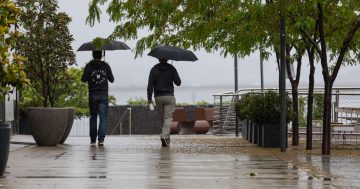
Huge hailstones have damaged vehicles and plants. Photo: Michelle Nixon Cooper / Facebook.
More than 6000 Canberra homes and businesses have been left without power after a severe storm whipped across the capital and surrounding areas.
EvoEnergy has been made aware of outages impacting parts of Ainslie, Dickson, Downer, Watson, Lyneham, Gungahlin, Hackett, Majura, Sutton, Campbell, Curtin, Holder, Monash, Richardson, Isabella Plains, Red Hill and O’Connor.
The Bureau of Meteorology has warned the threat of more storms remains for the next few hours.
It’s as a trough extending from northwest NSW through central parts of the state is generating storms from the hot and humid conditions, ahead of a strengthening upper trough that will mean temperatures across the Territory drop tomorrow (Wednesday, 20 December).
Damaging winds, large hailstones and flash flooding are also possible over the next few hours, not just for the Canberra area, but also for Batemans Bay and Goulburn.
Hail damage has already been reported in some parts of Canberra.
One Franklin woman said both her new cars and caravan now looked like “a teen with acne issues” following the ferocious storm.
“Sadly including the hatch in the roof of the van being smashed. We also lost half our front tree which was so pretty,” she said.
Another man who had his car parked at the new high school in Kenny also witnessed damage to several cars.
“My new ute I have had for four weeks is pretty bad,” he said.

Damaging winds, large hailstones and heavy rain remain possible across the warning areas. Photo: BOM.
The State Emergency Service advises that people should:
- Move your car under cover or away from trees
- Secure or put away loose items around your house, yard and balcony
- Keep at least 8 metres away from fallen power lines or objects that may be energised, such as fences
- Report fallen power lines to either Ausgrid (131 388), Endeavour Energy (131 003), Essential Energy (132 080) or Evoenergy (131 093) as shown on your power bill
- Trees that have been damaged by fire are likely to be more unstable and more likely to fall
- Keep clear of creeks and storm drains
- Don’t walk, ride your bike or drive through flood water
- If you are trapped by flash flooding, seek refuge in the highest available place and ring 000 if you need rescue
- Be aware that run-off from rainfall in fire-affected areas may behave differently and be more rapid. It may also contain debris such as ash, soil, trees and rocks
- After bushfires, heavy rain and the loss of foliage can make the ground soft and heavy, leading to a greater chance of landslides
- Unplug computers and appliances
- Avoid using the phone during the storm
- Stay indoors away from windows, and keep children and pets indoors as well
- Stay vigilant and monitor conditions. Note that the landscape may have changed following bushfires
For emergency help in floods and storms, ring the SES (NSW and ACT) on 132 500.





















